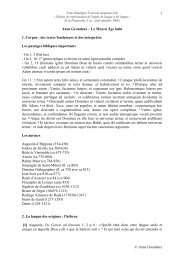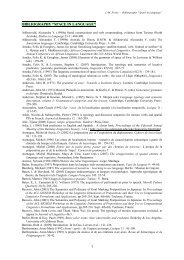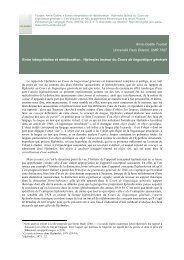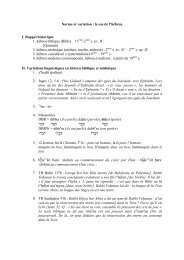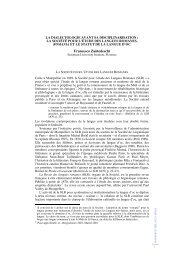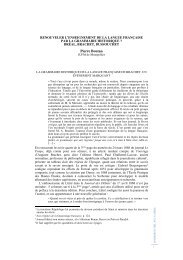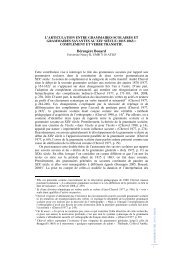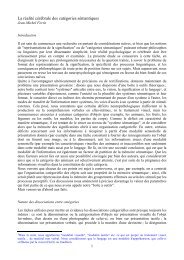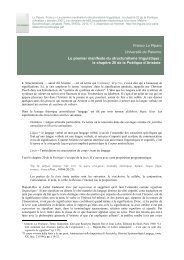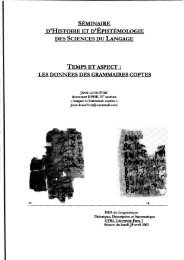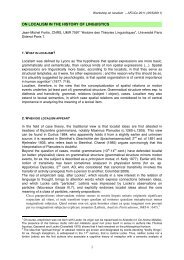What is localism? - Histoire des théories linguistiques
What is localism? - Histoire des théories linguistiques
What is localism? - Histoire des théories linguistiques
You also want an ePaper? Increase the reach of your titles
YUMPU automatically turns print PDFs into web optimized ePapers that Google loves.
On the h<strong>is</strong>tory and speciation of local<strong>is</strong>m<br />
Jean-Michel Fort<strong>is</strong><br />
Université Par<strong>is</strong> Diderot<br />
Research Unit “H<strong>is</strong>toire <strong>des</strong> Théories Lingu<strong>is</strong>tiques”<br />
CLM - 2012<br />
CECC - Universidade Católica Portuguesa<br />
1
<strong>What</strong> <strong>is</strong> local<strong>is</strong>m?<br />
Local<strong>is</strong>m <strong>is</strong> “the hypothes<strong>is</strong> that spatial expressions are more basic,<br />
grammatically and semantically, than various kinds of non spatial expressions<br />
(…). Spatial expressions are lingu<strong>is</strong>tically more basic, according to the local<strong>is</strong>ts,<br />
in that they serve as structural templates, as it were, for other expressions ; and<br />
the reason why th<strong>is</strong> should be so, it <strong>is</strong> plausibly suggested by psycholog<strong>is</strong>ts, <strong>is</strong><br />
that spatial organization <strong>is</strong> of central importance in human cognition” ( Lyons<br />
1977: 718).<br />
� Lingu<strong>is</strong>tic aspect (semiogenetic)<br />
� Cognitive aspect<br />
� “more basic”: there <strong>is</strong> an asymmetry in lexicalization / grammaticalization<br />
(doesn’t mean all relations are originally spatial)<br />
� In addition, local<strong>is</strong>m may concern semantic analys<strong>is</strong>: spatial relations are<br />
considered to be of central importance in analyzing the meaning of a lexical /<br />
grammatical item.<br />
2
When did local<strong>is</strong>m appear? (1)<br />
Traditional view (Hjelmslev 1935 etc.): local<strong>is</strong>m can be traced back to<br />
Byzantine grammarians, notably Maximus Planu<strong>des</strong> (c.1260-c.1310).<br />
“Here it <strong>is</strong> also to be noticed how by some sort of natural agreement the<br />
three questions ‘whence ?’, ‘where ?’ and ‘whither ?’ have had<br />
assigned to them the three oblique cases, ‘whence ?’ having the<br />
genitive, ‘where ?’ the dative and ‘whither ?’ the accusative ; and as in<br />
the noun paradigm, the genitive comes first, then the dative, and then<br />
the accusative, so too ‘whence ?’ [πόθεν] comes first, then<br />
‘where?’ [ποῦ], and then ‘whither ?’ [πῆ], corresponding to three<br />
div<strong>is</strong>ions of time.”<br />
In Bachmann (Anecdota Graeca, 1828, vol. 2, 122.23-27, transl.<br />
Robins 1993)<br />
3
When did local<strong>is</strong>m appear? (2)<br />
Problems:<br />
Chanet (1985): Planu<strong>des</strong> <strong>is</strong> in fact trying to find a “natural” motivation<br />
for the conventional order of cases in Greek grammars.<br />
Planu<strong>des</strong> has no h<strong>is</strong>torical role in the advent of modern local<strong>is</strong>m<br />
(he <strong>is</strong> red<strong>is</strong>covered quite late, by (?) Karl Ernst August Schmidt 1847,<br />
1859). Schmidt <strong>is</strong> the source of Hübschmann (1875).<br />
4
When did local<strong>is</strong>m appear? (3)<br />
Transitivity has been analyzed in physical<strong>is</strong>t terms. For ex. ap.<br />
Apollonius Dyscoles, 2 nd cent. AD:<br />
• Apollonius (III, 395, 12, p.254) :<br />
ἡ ἐνέργεια ὡς πρὸς ὑποκείµενόν τι διαβιβάζεται, ὡς τὸ τέµνει, τύπτει<br />
(‘activity undergoes a transition to an object, like in he cuts / hits’)<br />
Th<strong>is</strong> “physical<strong>is</strong>t” view <strong>is</strong> applied in part. to V of perception.<br />
• Cf. also Byzantine grammarians and mod<strong>is</strong>t grammar.<br />
5
The real emergence of local<strong>is</strong>m<br />
I suggest that local<strong>is</strong>m gains a real foothold in a context where the<br />
following conditions are met, i.e. in the 17 th century:<br />
• 1. Space has a special status in ep<strong>is</strong>temology and culture at large.<br />
• 2. For an analys<strong>is</strong> of lingu<strong>is</strong>tic forms in terms of spatial relations to be<br />
pursued at all, th<strong>is</strong> analys<strong>is</strong> must be considered worthwhile. An<br />
important justification <strong>is</strong> that language provi<strong>des</strong> a window on the mind.<br />
• 3. Since “spatial” markers have other meanings, it must make sense to<br />
regard space as more important than other aspects.<br />
• 4 . Markers with a supposedly spatial meaning are studied for their<br />
own sake.<br />
6
Condition 1 : the status of space<br />
• The 17 th century witnesses a revival of atom<strong>is</strong>tic philosophy.<br />
• E.g. in Boyle’s account substantial forms are re<strong>des</strong>cribed as<br />
modifications of size, shape, motion and texture (spatial arrangement)<br />
of the corpuscules.<br />
• Descartes <strong>des</strong>cribes the essence of bodies as “extension”.<br />
• Cf. also controversies on the ex<strong>is</strong>tence of void, and the Leibniz-<br />
Newton d<strong>is</strong>pute on the ex<strong>is</strong>tence of absolute space.<br />
7
Condition 2 : language as a window on the mind<br />
Empiric<strong>is</strong>m favors some forms of nominal<strong>is</strong>m.<br />
Extreme form in Hobbes: only words are universal, and truth being<br />
about universals, true and false are attributes of speech (th<strong>is</strong><br />
scandalized many).<br />
Context of “m<strong>is</strong>oglossy” (but which reflects a trust in the power of<br />
language), gap between real / nominal essence.<br />
Locke’s empiric<strong>is</strong>t views will be turned into a theory on the semiotic<br />
genes<strong>is</strong> of thought by Condillac (a move of great importance, cf.<br />
Aarsleff 1982, 1983).<br />
8
Condition 2 : language as a window on the mind<br />
Other factors:<br />
The dem<strong>is</strong>e of ancient logic, which results from flaws inherent in<br />
ancient logic (because it fails to capture some mo<strong>des</strong> of reasoning in<br />
natural language and in science), and the consequent interest in<br />
reasoning conducted in natural language (esp. during the 18th; Auroux<br />
1995)<br />
A constant interest for lingu<strong>is</strong>tic (and ethnological) diversity<br />
(“grammat<strong>is</strong>ation” of vernacular languages and of languages in the<br />
sphere of influence of European imperial<strong>is</strong>m explo<strong>des</strong> during the 16 th ,<br />
e.g. 4 grammars of Nahuatl publ<strong>is</strong>hed in 80 years betw. 1595 and 1673;<br />
Auroux 1992)<br />
9
Condition 3 : space <strong>is</strong> an important aspect of meaning<br />
• More generally, the importance devolved to space fits in an empiric<strong>is</strong>t<br />
ep<strong>is</strong>temology: “…we should find, in all Languages, the Names which<br />
stand for things that fall not under our Senses, to have had their first<br />
r<strong>is</strong>e from sensible Ideas…” (Locke, ECHU, II.i.x, §103)<br />
• Th<strong>is</strong> requires a way to go from space to other dimensions: metaphors<br />
(Clauberg, Lamy, Leibniz; Formigari 1988).<br />
10
Condition 4 : cases and prep. studied for their own sake<br />
Semantic analyses are favored by the fact that contextual <strong>des</strong>criptions<br />
of relators (e.g. appealing to verb classes, or <strong>des</strong>cribing the abl. as a<br />
prepositional case) progressively give way (in the 18 th ) to <strong>des</strong>criptions<br />
singling out prepositions and cases as bearers of meaning in their own<br />
right (Colombat 1981).<br />
Wüllner (1827) will analyze tinos in akoúein tinos ‘hear sth GEN ’ not as<br />
dependent on a perception V (like Apollonius), but as an instance of<br />
one acception of the genitive (‘receptive’).<br />
11
Consequence: language as evidence for the primacy of<br />
sensible ideas, and application to “particles”<br />
Leibniz claims that “languages are the best mirror of the human mind,<br />
and that an exact analys<strong>is</strong> of the signification of words would give insight<br />
into the operations of the understanding better than any other<br />
means.” (NE III.vii.6)<br />
Hence also the interest in etymology.<br />
Cf. Turgot: etymology as a branch of “métaphysique expérimentale”.<br />
Cf. Horne Tooke (a nominal<strong>is</strong>t) in England and h<strong>is</strong> ΕΠΕΑ ΠΤΕΡΟΕΝΤΑ<br />
or, the Diversions of Purley (1786-1805; Aarsleff 1983).<br />
12
Consequence: language as evidence for the primacy of<br />
sensible ideas, and application to “particles”<br />
Leibniz both corrects Locke and vindicates Locke’s empiric<strong>is</strong>m by taking<br />
up the challenge of particles (“not truly the names of Ideas”), i.e. he<br />
seeks a cognitive justification for them. Instead of conjunctions (like but),<br />
he turns to prepositions and says:<br />
“Circa praepositiones observandum videtur omnes in nostr<strong>is</strong> lingu<strong>is</strong><br />
usitat<strong>is</strong> originarie significare respectum ad situm, et inde transferri<br />
tropo quodam ad notiones quasdam metaphysicas minus imaginationi<br />
subjectas.”<br />
Leibniz, De Lingua Philosophica, 1687-8<br />
However, Leibniz <strong>is</strong> not an empiric<strong>is</strong>t!<br />
13
Consequence: language as evidence for the primacy of<br />
sensible ideas, and application to “particles”<br />
In h<strong>is</strong> De Lingua Philosophica (c. 1687), Leibniz analyzes prep. by<br />
resorting to topological and part / whole relations, rest and motion,<br />
presence of one or 2 landmarks (e.g. avec c<strong>is</strong> : B c<strong>is</strong> C = B inter me et<br />
C), fictive motion (for per, as in diametrum transire per circulum, p.<br />
892-3), gravity and conatus (pour infra / supra), projection of the human<br />
face (anterior part of a house, p.893)<br />
Metaphorization explains how non-physical notions can be apprehended<br />
in physical terms.<br />
14
Expansion of local<strong>is</strong>m<br />
Harr<strong>is</strong>, in h<strong>is</strong> Hermes (1765, foundations for a universal grammar),<br />
draws a parallel between prepositions (including prefixes, as in foretell,<br />
overact, undervalue ; p.271) and cases.<br />
The primary meaning of prepositions <strong>is</strong> spatial :<br />
“But though the original use of Prepositions was to denote the<br />
Relations of Place, they could not be confined to th<strong>is</strong> Office only. They<br />
by degrees extended themselves to Subjects incorporeal, and came to<br />
denote Relations, as well intellectual as local. Thus, because in Place<br />
he, who <strong>is</strong> above, has commonly the advantage over him, who <strong>is</strong><br />
below, hence we transfer OVER and UNDER to Dominion and<br />
Obedience.” (Hermes, p.268)<br />
15
Expansion of local<strong>is</strong>m<br />
Like Harr<strong>is</strong>, Condillac (1765, vol. II, chap. 13) claims that the primary<br />
meaning of prep. <strong>is</strong> spatial.<br />
� Local<strong>is</strong>m <strong>is</strong> an empiric<strong>is</strong>t view adaptable to all frameworks:<br />
UG, like Harr<strong>is</strong>’, empiric<strong>is</strong>t, nominal<strong>is</strong>t and “rational<strong>is</strong>t” theories.<br />
16
The German context<br />
Empiric<strong>is</strong>m and importance of Kant’s ideas, esp. Anschauung<br />
‘intuition’ as mediating the understanding of concepts through<br />
experience in space and time.<br />
After Kant, an empiric<strong>is</strong>t movement contests (but also situates itself<br />
with respect to) Kant’s philosophy (Formigari 1994). Emphas<strong>is</strong> on the<br />
role of the body, on “natural” categories, on lingu<strong>is</strong>tic cognition etc. Cf.<br />
Herder’s Metakritik and h<strong>is</strong> “phenomenology” of concepts (Sein, Dasein<br />
> Raum, Dauer > Zeit, Kraft).<br />
During the 19 th , space becomes a major concern of the theory of<br />
cognition: spatial perception involves physics, physiology and<br />
psychology (Hatfield 1990). Cf. the Helmholtz – Hering controversy on<br />
nativ<strong>is</strong>m.<br />
17
The German context<br />
Language itself <strong>is</strong> seen as the repository of the conditions of thought (a<br />
sort of lingu<strong>is</strong>tic tw<strong>is</strong>ting of Kantian philosophy), with an ins<strong>is</strong>tence on<br />
human spontaneity and freedom in the creation of lingu<strong>is</strong>tic forms.<br />
Cf. W. v. Humboldt, who holds local<strong>is</strong>t views in h<strong>is</strong> (1830) Die<br />
Verwandtschaft der Ortsadverbien mit dem Pronomen in einigen<br />
Sprachen: pronouns are derived from locative adverbs: spatial intuition<br />
mediates the conception underlying forms which, like pronouns,<br />
abstract away from qualitative determinations.<br />
(to be noted: H.'s data do not come from classical lang. but from Armenian,<br />
Chinese, Japanese, Tongan, Maori).<br />
18
A local<strong>is</strong>t theory of case: Wüllner (1827)<br />
The basic meanings (Grundbedeutungen) of the genitive, accusative<br />
and dative cases are spatial intuitions (Anschauungen), resp. of a<br />
starting point (woher ‘where from’), of a goal (wohin ‘where to’) and a<br />
localization (wo ‘where’).<br />
The acceptions of a case are derived from the basic meaning, just like<br />
in a radiating network.<br />
19
Diachrony and generalized local<strong>is</strong>m: Wüllner (1831)<br />
Wüllner <strong>is</strong> a student of Bopp.<br />
Bopp had shown that some endings of Sanskrit, Latin and Greek<br />
declensions came from demonstratives or prepositions with an<br />
“originally” spatial meaning, and that at least some prepositions were<br />
closely related to demonstratives (Bopp 1826).<br />
Similarly, in W.'s theory, substantives and adjectives are hypothesized<br />
to have pronominal (and ultimately, demonstrative) endings, on the<br />
ground that pronouns serve to anchor a referent in space (1831: 272-3;<br />
many data from Sanskrit).<br />
21
Another local<strong>is</strong>t: Hartung<br />
Hartung (1831) Über die Casus. Ihre Bildung und Bedeutung in der<br />
Griech<strong>is</strong>chen und Latein<strong>is</strong>chen Sprache. Independent from Wüllner.<br />
Gen. Acc. Inst. Abl. Dat.<br />
source goal location base direction<br />
(Hartung’s vocabulary <strong>is</strong> organic<strong>is</strong>t, vital<strong>is</strong>t; cf. also influence of<br />
Naturphilosophie ap. Michelsen, 1843, Philosophie der Grammatik<br />
unter steter Leitung der Geschichte I. Kasuslehre der latein<strong>is</strong>chen<br />
Sprache vom kausal-lokalen Standpunkte aus)<br />
22
Problems with local<strong>is</strong>m<br />
Local<strong>is</strong>m faces problems (Rumpel 1845, 1866; Curtius 1864):<br />
• it has nothing to say about the nominative, the case of the subject. Yet, the<br />
subject-predicate structure <strong>is</strong> the most important cognitive fact.<br />
• the derived meanings are too specific (confusion between the materiale<br />
Bedeutung of the context with the meaning of grammatical forms).<br />
• the genitive <strong>is</strong> strongly associated with nominal determination, and its spatial<br />
uses seem to be marginal at best.<br />
•the accusative <strong>is</strong> generally not replaced by a prep.<br />
23
Semi-local<strong>is</strong>m<br />
Ahrens (1852) first (d<strong>is</strong>tinction between “logical” and “topical” cases)<br />
Holzwe<strong>is</strong>sig (1877), Wahrheit und Irrthum der local<strong>is</strong>t<strong>is</strong>chen Casustheorie<br />
Grammatical cases Local cases (Sanskrit)<br />
nominative dative (Wohin)<br />
vocative ablative (Woher)<br />
accusative locative (Wo)<br />
genitive instrumental-sociative<br />
(Womit)<br />
In Latin and Greek, cases are red<strong>is</strong>tributed or merged. E.g. dative (or ablative),<br />
after having absorbed the locative case, came to be associated with stas<strong>is</strong>,<br />
while the meaning of the accusative was extended to goals (i.e. in an<br />
“antilocal<strong>is</strong>t” direction). D<strong>is</strong>covery of syncret<strong>is</strong>m!<br />
24
Semi-local<strong>is</strong>m and semi-experiential<strong>is</strong>m<br />
Psycholog<strong>is</strong>m revives local<strong>is</strong>m, or better, experiential<strong>is</strong>m, cf. also<br />
Delbrück 1901 and Wundt 1912 3: in h<strong>is</strong> Völkerpsychologie:<br />
Internal determination External determination<br />
Nom. Abl.<br />
Voc. Loc.<br />
Acc. Instr.-Soc.<br />
Gen. Prosecutive (‘along’)<br />
Dat. Caritive …<br />
Criteria for cases of internal det.: can be also expressed by position /<br />
composition (Vaterhaus), are last to d<strong>is</strong>appear, limited in number, no<br />
semantic gap if m<strong>is</strong>sing.<br />
Criteria for cases of external determination are opposite.<br />
25
The posterity of case (semi-)local<strong>is</strong>m<br />
Hjelmslev (1935-7), La catégorie <strong>des</strong> cas, surveys local<strong>is</strong>t theories,<br />
backs up Planu<strong>des</strong> and Wüllner, and endorses a local<strong>is</strong>t approach.<br />
Kuryłowicz (1949, 1964): cases are grammatical and concrete (except<br />
nom. / voc.), N <strong>is</strong> grammatical, Ac / Gen are primarily grammatical and<br />
I / L / Ab are primarily concrete. All obl. cases may have been originally<br />
spatial (1964).<br />
26
The posterity of case local<strong>is</strong>m<br />
Case local<strong>is</strong>m <strong>is</strong> revived by Anderson (1971).<br />
4 “deep” cases: nominative, ergative, locative, ablative; “deep” case ≠<br />
surface case,e.g. some surface nominatives are analyzed as deep<br />
locatives:<br />
In many people know part of the truth, many people <strong>is</strong> a deep locative.<br />
Close to Fillmore’s case grammar in spirit, and influenced by<br />
transformational grammar.<br />
Influence on cognitive lingu<strong>is</strong>tics? (Langacker, in a review of Anderson,<br />
says he <strong>is</strong> “basically sympathetic” to local<strong>is</strong>m).<br />
27
Cassirer’s local<strong>is</strong>m<br />
Cassirer (1953, Philosophie der symbol<strong>is</strong>chen Formen, neokant<strong>is</strong>m)<br />
suggests that lingu<strong>is</strong>tic local<strong>is</strong>m <strong>is</strong> one mode of apprehension of space<br />
(beside mythical thought or mathematical conceptions).<br />
Seems to hold an evolutionary view: some languages are more<br />
“concrete” (those of “primitive people”), all represent a step toward the<br />
construction of abstract relations.<br />
28
Local<strong>is</strong>m before cognitive lingu<strong>is</strong>tics: Gruber<br />
Gruber (1965): “deep” roles Source / Theme / Goal<br />
He notes that “positional” notions carry over to “identificational”,<br />
“possessional”, “class-membership” or communicational contexts:<br />
the coach turned into a pumpkin (identificational), John gave a book to<br />
Bill (possessional), John translated the letter from Russian to Engl<strong>is</strong>h<br />
(class membership), John reported to Mary that… (1965: 47s).<br />
Th<strong>is</strong> <strong>is</strong> called abstract motion.<br />
29
Local<strong>is</strong>m and pre-cognitive lingu<strong>is</strong>tics: Talmy<br />
Talmy (1972) compares the structure of Engl<strong>is</strong>h with a polysynthetic<br />
language of California, Atsugewi (he <strong>is</strong> facing the same problem as<br />
Chafe with Onondaga: the TG of Aspects <strong>is</strong> not adapted; Fort<strong>is</strong> 2011).<br />
Argues that both languages share a common deep structure.<br />
Talmy’s deep structure <strong>is</strong> the representation of a translatory situation.<br />
A translatory situation (an event in which a Figure moves along a path<br />
or <strong>is</strong> in a spatial relation to a Ground) <strong>is</strong> analyzed into a fixed structure<br />
(translatory structure) of 4 components :<br />
Figure, Motive , Directional , Ground.<br />
31
Local<strong>is</strong>m and cognitive lingu<strong>is</strong>tics: Talmy<br />
<strong>What</strong> <strong>is</strong> d<strong>is</strong>tinctly local<strong>is</strong>t in Talmy’s framework <strong>is</strong> that it <strong>is</strong> applied to<br />
non-spatial situations, esp. temporal and causative contexts<br />
(surface structures are derived via a process of conflation // pred.<br />
ra<strong>is</strong>ing in Generative Semantics, and via adjunctions of “peripheral”<br />
semantic components).<br />
“Situations that involve state and change of state seem to be organized<br />
by the human mind in such a way that they can be specified by<br />
structures homologous with motion structures” (Talmy 1975, p.234).<br />
33
Local<strong>is</strong>m and cognitive lingu<strong>is</strong>tics: Langacker<br />
Langacker's Space Grammar (= incipient Cogn. Gram.) reflects a drift<br />
from Langacker’s own version of generative semantics.<br />
At one point, Langacker’s generative trees (akin to what was found in<br />
generative semantics) give way to a stratal representation which <strong>is</strong><br />
regarded as iconic (strata, as it were, <strong>is</strong>omorphic to conceptualization);<br />
second, Langacker offers a spatial representation of modal auxiliaries,<br />
tenses and modalities (Langacker 1978, 1979; Fort<strong>is</strong> 2010b).<br />
A different type of local<strong>is</strong>m, where the relation between diagrammatic<br />
notation and cognitive local<strong>is</strong>m <strong>is</strong> not explicit (or so it seems).<br />
34
Local<strong>is</strong>m and cognitive lingu<strong>is</strong>tics: semantics<br />
Reawakening of lexical semantics in Am. lingu<strong>is</strong>tics, favored by the<br />
importation of aspects of Rosch’s prototype theory into lingu<strong>is</strong>tics (first<br />
by Lakoff 1973 on hedges; Fort<strong>is</strong> 2010a).<br />
Among the first studies, two on prepositions / particles: Brugman (1981)<br />
on over and Lindner (1981) on up / out (but see Bennett 1975 on Eng.<br />
prep. in a stratificational framework and Miller & Johnson-Laird 1976,<br />
on the interface lang. / perception).<br />
35
Why <strong>is</strong> space so important in cognitive lingu<strong>is</strong>tics?<br />
Convergence of local<strong>is</strong>m / metaphorization with diachronic studies /<br />
grammaticalization research (e.g. Claudi & Heine 1986, Heine 1997,<br />
Fagard 2010)<br />
Interconnections built around the core of an empiric<strong>is</strong>t semiotics:<br />
semantics / metaphors / diachrony / mental spaces and<br />
blending / embodiment.<br />
36
By way of conclusion: a typology of local<strong>is</strong>ms<br />
• Cognitive local<strong>is</strong>m (ambiguous: relations are conceptualized in<br />
spatial terms, or relations take their origin in spatial conceptualization)<br />
• Semiogenetic local<strong>is</strong>m: on lexicalization (can be accepted without<br />
subscribing to cognitive local<strong>is</strong>m; cf. Marty 1910, Die “log<strong>is</strong>che”,<br />
“lokal<strong>is</strong>t<strong>is</strong>che” und andere Kasustheorien )<br />
• Semantic local<strong>is</strong>m: on basic or “prototypical” meanings<br />
• Evolutionary local<strong>is</strong>m (not clearly connected with lexical local<strong>is</strong>m in<br />
Cassirer, coex<strong>is</strong>ts with a form of cognitive local<strong>is</strong>m)<br />
• Diagrammatic local<strong>is</strong>m (e.g. Langacker)<br />
37
THANK YOU !<br />
38
References<br />
• Aarsleff, Hans, 1982, From Locke to Saussure, Minneapol<strong>is</strong>, University of Minnesota<br />
Press.<br />
• Aarsleff, Hans, 1983, The study of language in England (1780-1860), Minneapol<strong>is</strong> /<br />
London, University of Minnesota Press / The Athlone Press.<br />
• Anderson, John M., 1971, The grammar of case: Towards a local<strong>is</strong>tic theory. London,<br />
Cambridge University Press.<br />
• Anderson, John M., 1973, « Maximi Planud<strong>is</strong> in memoriam », Generative grammar in<br />
Europe, F. Kiefer & N. Ruwet (eds), Dordrecht, Reidel, p.20-47.<br />
• Auroux, Sylvain, 1983, La logique <strong>des</strong> idées, Par<strong>is</strong>, Bellarmin / Vrin.<br />
• Auroux, Sylvain (dir.), 1992, H<strong>is</strong>toire <strong>des</strong> idées lingu<strong>is</strong>tiques, tome 2, Bruxelles,<br />
Mardaga.<br />
• Bopp, Franz, 1826, « Vergleichende Zergliederung <strong>des</strong> Sanskrits und der mit ihm<br />
verwandten Sprachen. III. Demonstrativum und Casuszeichen », Abhandlungen der<br />
Berliner Akademie, Philolog<strong>is</strong>ch-H<strong>is</strong>tor<strong>is</strong>che Klasse, p.65-102.<br />
• Bopp, Franz, 1865 [1833], Grammaire comparée <strong>des</strong> langues indo-européennes<br />
comprenant le sanscrit, le zend, l’arménien, le grec, le latin, le lithuanien, l’ancien<br />
slave, le gothique et l’allemand, trad. par Michel Bréal, Par<strong>is</strong>, L. Hachette et C ie .<br />
• Brugman, Claudia,1981, Story of Over. M.A. Thes<strong>is</strong>, University of California, Berkeley.<br />
• Cassirer, Ernst 1953, Philosophie der symbol<strong>is</strong>chen Formen, Yale University Press.<br />
• Chanet, Anne-Marie, 1985, « Maxime Planude, local<strong>is</strong>te? », H<strong>is</strong>toire Ep<strong>is</strong>témologie<br />
Langage, n°7(1), p.127-148.<br />
39
References<br />
• Claudi, Ulrike & Heine, Bernd,1986, « On the metaphorical bas<strong>is</strong> of grammar », Studies<br />
in Language 10(2), 297-335.<br />
• Colombat, Bernard, 1981, « Préposition, cas et syntaxe latine dans l’Encyclopédie »,<br />
3(2), 3-20.<br />
• Colombat, Bernard, 2009, «Les fondements sémantiques de la transitivité : A la<br />
recherche de la personne». In Evrard, Ivan, Pierrard, Michel, Rosier, Laurence & Van<br />
Raemdonck (2009) Représentations du sens lingu<strong>is</strong>tique 3. Actes du Colloque<br />
international RSL III (Bruxelles, 3-5 novembre 2005), Bruxelles, De Boeck-Duculot,<br />
285-318.<br />
• Condillac, Etienne Bonnot de, 1765, Cours d’étude pour l’instruction du prince de<br />
Parme. Grammaire, Parme, Imprimerie Royale.<br />
• Curtius, Georg, 1864, « Über die local<strong>is</strong>t<strong>is</strong>che Auffassung der Casus », Verhandlungen<br />
der einundzwanzigsten Versammlung Deutscher Philologen und Schulmänner, 30.<br />
September-2. October 1863, Leipzig, Teubner, 45-50.<br />
• Delbrück Berthold, 1897-1916, Vergleichende Syntax der indogerman<strong>is</strong>chen Sprachen<br />
(= Brugmann Karl & Delbrück Berthold, Grundriß der vergleichenden Grammatik der<br />
indogerman<strong>is</strong>chen Sprachen, III), Straßburg, Trubner.<br />
• Delbrück, Berthold, 1901, Grundfragen der Sprachforschung, Strasbourg, Verlag von<br />
Karl J. Trübner.<br />
40
References<br />
• Döleke, Wilhelm Heinrich, 1814, Versuche philosoph<strong>is</strong>ch-grammat<strong>is</strong>cher Bemerkungen<br />
II. Über die Casus, die Tempora, das Pronomen und das Verbum Substantivum.<br />
Leipzig, Joh. Ambrosius Barth.<br />
• Fagard, Benjamin, 2010, Espace et grammatical<strong>is</strong>ation. L’évolution sémantique es<br />
prépositions dans les langues romanes, Sarrebruck, Editions Universitaires<br />
Européennes.<br />
• Formigari, Lia, 1988, Language and Experience in 17th Century Brit<strong>is</strong>h Philosophy,<br />
Amsterdam / Philadelphia, John Benjamins.<br />
• Formigari, Lia, 1994, La sémiotique empir<strong>is</strong>te face au kant<strong>is</strong>me, Bruxelles, Mardaga.<br />
• Fort<strong>is</strong>, Jean-Michel, 2010a, « De l'hypothèse de Sapir-Whorf au prototype: sources et<br />
genèse de la théorie d'Eleanor Rosch », Revue en ligne Corela, 8(2).<br />
• Fort<strong>is</strong>, Jean-Michel, 2010b, « De la grammaire générative à la Grammaire Cognitive:<br />
Origines et formation de la théorie de Ronald Langacker », H<strong>is</strong>toire Ep<strong>is</strong>témologie<br />
Langage 32(2), 109-49.<br />
• Gruber, Jeffrey S., 1965, Studies in lexical semantics, MIT Working Papers in<br />
Lingu<strong>is</strong>tics.<br />
• Harr<strong>is</strong>, James, 1765, Hermes or a philosophical inquiry concerning universal grammar,<br />
London, John Nourse & Paul Vaillant.<br />
• Heine, Bernd, 1997, Cognitive foundations of grammar, Oxford, Oxford University<br />
Press.<br />
41
References<br />
• Hartung, Johann Adam, 1831, Über die Casus, ihre Bildung und Bedeutung in der<br />
griech<strong>is</strong>chen und latein<strong>is</strong>chen Sprache, Erlangen, Palm und Enke.<br />
• Hjelmslev, Lou<strong>is</strong>, 1972 [1935-7], La catégorie <strong>des</strong> cas, Copenhague,<br />
Universitetsforlager I Aarhus [reprint La catégorie <strong>des</strong> cas, München, Wilhelm Fink<br />
Verlag, 1972].<br />
• Holzwe<strong>is</strong>sig, Friedrich W., 1877, Wahrheit und Irrthum der local<strong>is</strong>t<strong>is</strong>chen Casustheorie,<br />
Leipzig, Teubner.<br />
• Hübschmann, Heinrich, 1875, Zur Casuslehre, München, Theodor Ackermann.<br />
• Humboldt, Wilhelm von, 1830, Über die Verwandtschaft der Ortsadverbien mit dem<br />
Pronomen in einigen Sprachen, Berlin, Druckerei der Königlichen Akademie der<br />
W<strong>is</strong>senschaften.<br />
• Jackendoff, Ray, 1976, « Toward an explanatory semantic representation », Lingu<strong>is</strong>tic<br />
Inquiry 7(1), p.89-150.<br />
• Jackendoff, Ray, 1983, Semantics and cognition, Cambridge (Mass.), MIT Press.<br />
• Kuryłowicz, Jerzy, 1949, « Le problème du classement <strong>des</strong> cas », Bulletin de la Société<br />
polona<strong>is</strong>e de Lingu<strong>is</strong>tique 9, 20-43.<br />
• Kuryłowicz, Jerzy, 1964, The inflectional categories of Indo-European, Heidelberg, Carl<br />
Winter.<br />
• Lakoff, George, 1973, Hedges : A study in meaning criteria and the logic of fuzzy<br />
concepts, Journal of Philosophical Logic 2 : 458-508.<br />
42
References<br />
• Langacker, Ronald W., 1978, « The form and meaning of the Engl<strong>is</strong>h auxiliary »,<br />
Language 54, 853-882.<br />
• Langacker, Ronald W., 1979, « Grammar as image », Lingu<strong>is</strong>tic Notes from La Jolla, La<br />
Jolla, Cal., 6, 87-126.<br />
• Leibniz, Gottfried Wilhelm, 1923- [1685-1686], « Analys<strong>is</strong> particularum », Sämtliche<br />
Schriften und Briefe, Deutsche Akademie der W<strong>is</strong>senschaften zu Berlin, Darmstadt, VI<br />
4, p.646-67.<br />
• Leibniz, Gottfried Wilhelm, 1923- [1687-1688], « De lingua philosophica », Sämtliche<br />
Schriften und Briefe, Deutsche Akademie der W<strong>is</strong>senschaften zu Berlin, Darmstadt, VI<br />
4, p.881-908.<br />
• Leibniz, Gottfried Wilhelm, 1966 [1765], Nouveaux essa<strong>is</strong> sur l’entendement humain,<br />
Par<strong>is</strong>, Garnier Flammarion.<br />
• Lindner, Susan J., 1981, A Lexico-Semantic Analys<strong>is</strong> of Engl<strong>is</strong>h Verb-Particle<br />
Constructions UP and OUT, d<strong>is</strong>sertation, University of California, San Diego.<br />
• Locke, John, 1975 [1700], An essay concerning human understanding, Oxford, Oxford<br />
University Press.<br />
• Lyons, John (1977) Semantics, 2 vol., Cambridge, Cambridge University Press.<br />
• Marty, Anton, 1910, Die “log<strong>is</strong>che”, “lokal<strong>is</strong>t<strong>is</strong>che” und andere Kasustheorien. Halle<br />
a.S., Max Niemeyer.<br />
43
References<br />
• Michelsen, Conrad, 1843, Philosophie der Grammatik unter steter Leitung der<br />
Geschichte I. Kasuslehre der latein<strong>is</strong>chen Sprache vom kausal-lokalen Standpunkte<br />
aus. Berlin, T. Trautwein.<br />
• Miller, George & Johnson-Laird, Philip N., 1976, Language and perception, Cambridge,<br />
Harvard University Press.<br />
• Parret, Herman, 1989, « Cognition, the local<strong>is</strong>t hypothes<strong>is</strong> and back to Kant », Worlds<br />
Behind Words. Essays in Honour of Professor F.G. Droste on the Occasion of h<strong>is</strong><br />
Sixtieth Birthday, F.J. Heyvaert & F. Steurs eds., Leuven, Leuven University Press, p.<br />
37-49.<br />
• Robins, Robert Henry (1993) « Maximus Planu<strong>des</strong>: A Byzantine theoretician ». In<br />
Robins, R.H. The Byzantine grammarians: their place in h<strong>is</strong>tory, p.201-234.<br />
• Rumpel, Theodor, 1845, Die Casuslehre in besonderer Beziehung auf die griech<strong>is</strong>che<br />
Sprache, Halle, Eduard Anton.<br />
• Rumpel, Theodor, 1866, « Zur Casustheorie », Programm <strong>des</strong> evangel<strong>is</strong>chen<br />
Gymnasiums zu Gütersloh, p.1-25.<br />
• Schmidt, Karl Ernst August, 1847, « Zur Erklärung und Würdigung der grammat<strong>is</strong>chen<br />
Kunstausdrücke », Zeitschrift für die W<strong>is</strong>senschaft der Sprache. Volume 2, Cahier 1,<br />
Albert Hoefer hrsg, Berlin, G. Reimer, p.57-75.<br />
• Schmidt, Karl Ernst August, 1859, Beiträge zur Geschichte der Grammatik <strong>des</strong><br />
Griech<strong>is</strong>chen und Latein<strong>is</strong>chen, Halle, Buchhandlung <strong>des</strong> Wa<strong>is</strong>enhauses.<br />
• Serbat, Guy, 1981, Cas et fonctions., Par<strong>is</strong>, Presses Universitaires de France.<br />
44
References<br />
• Talmy, Leonard, 1972, Semantic structures in Engl<strong>is</strong>h and Atsugewi, D<strong>is</strong>sertation,<br />
University of California, Berkeley.<br />
• Talmy, Leonard, 1975, « Semantics and syntax of motion », Syntax and semantics, vol.<br />
4. Edité par John P. Kimball. New York: Academic Press, 181-238.<br />
• Wüllner, Franz, 1827, Die Bedeutung der sprachlichen Casus und Modi, Münster,<br />
The<strong>is</strong>sigsche Buchhandlung.<br />
• Wüllner, Franz, 1831, Über Ursprung und Urbedeutung der sprachlichen Formen,<br />
Münster, The<strong>is</strong>sigsche Buchhandlung.<br />
• Wundt, Wilhelm, 1912 3 , Völkerpsychologie. Eine Untersuchung der<br />
Entwicklungsgesetze von Sprache, Mythos und Sitte. 2. Bd, 2. Teil. Leipzig, Verlag von<br />
Wilhelm Engelmann.<br />
45



